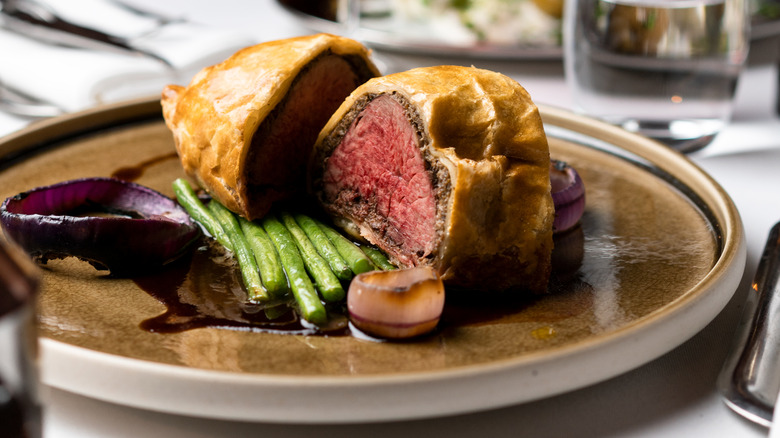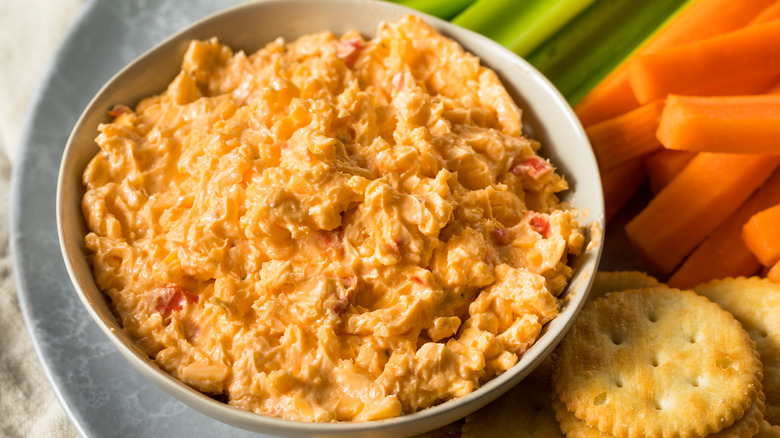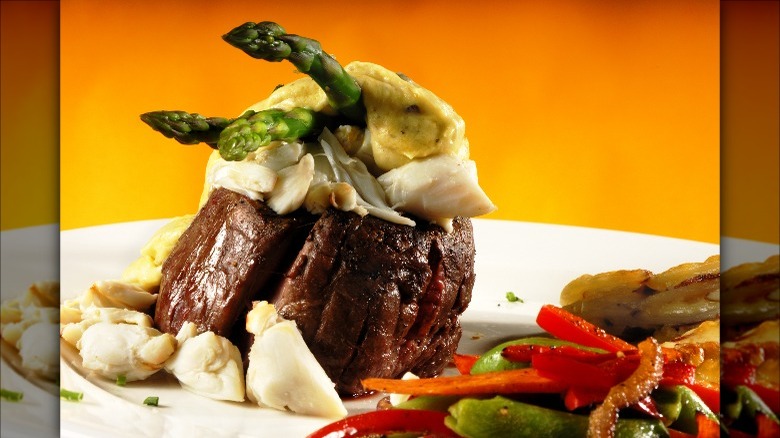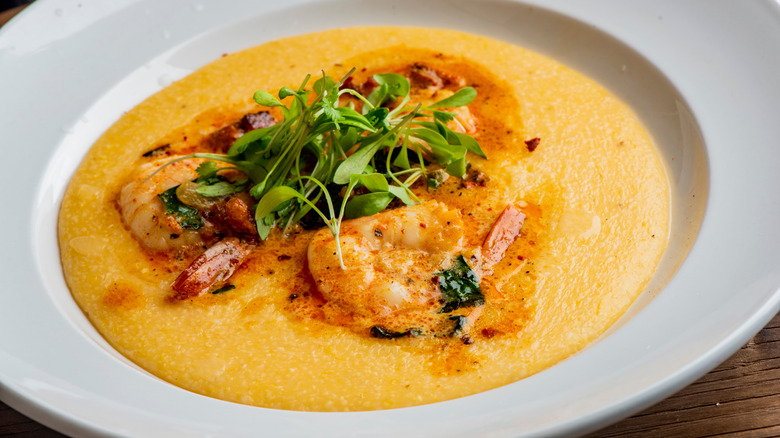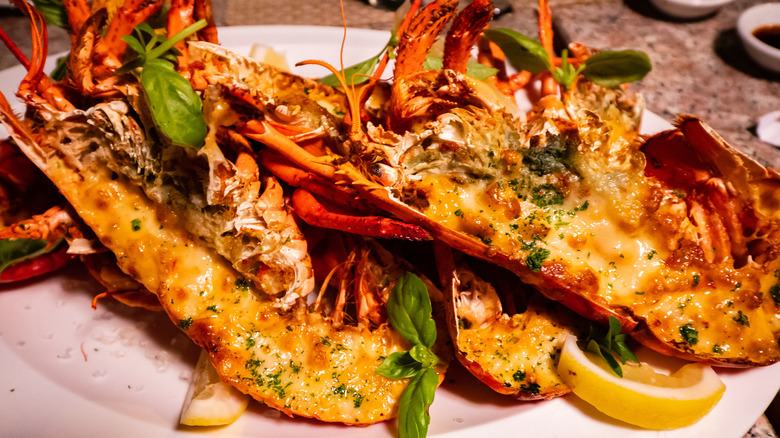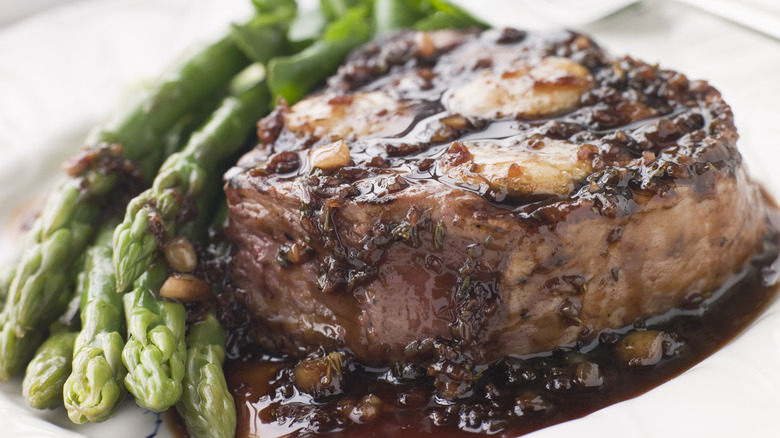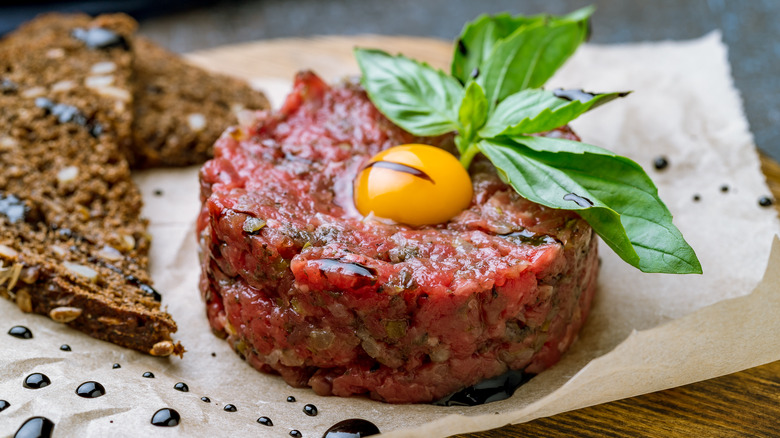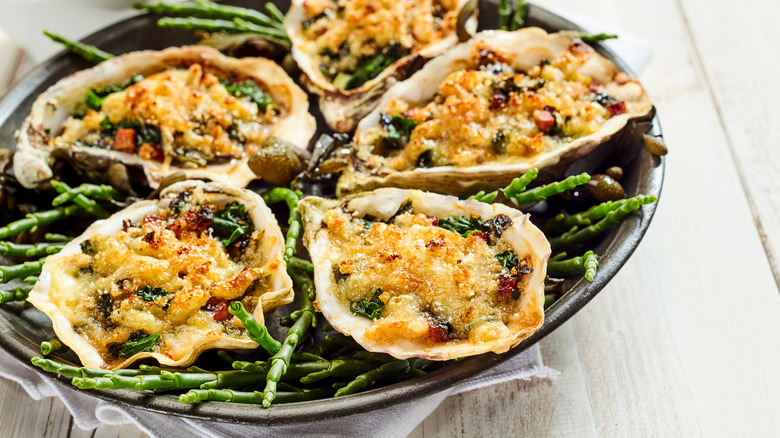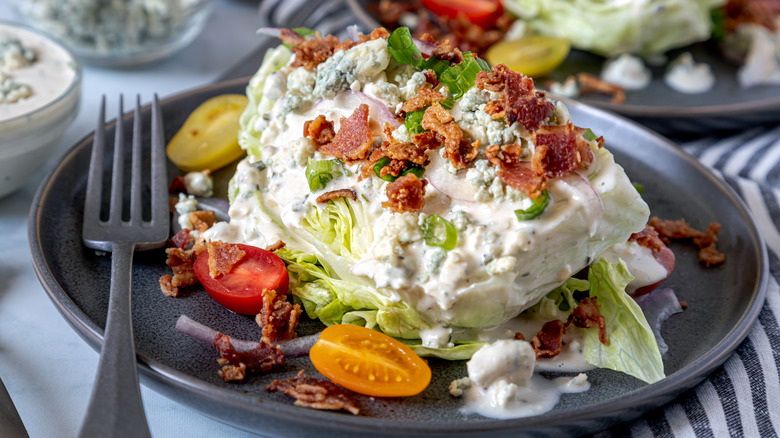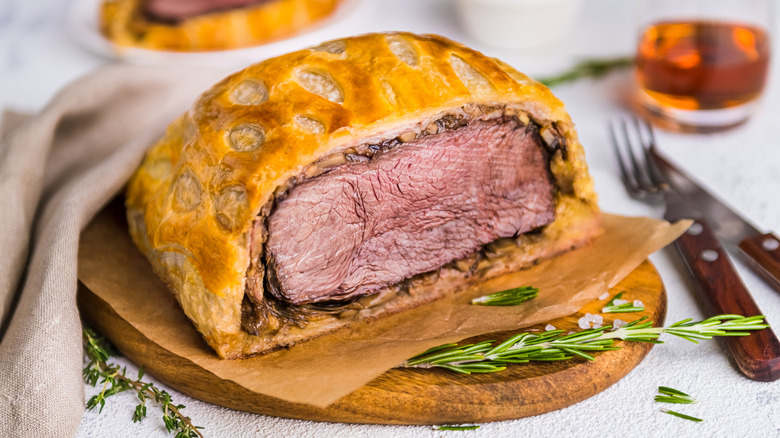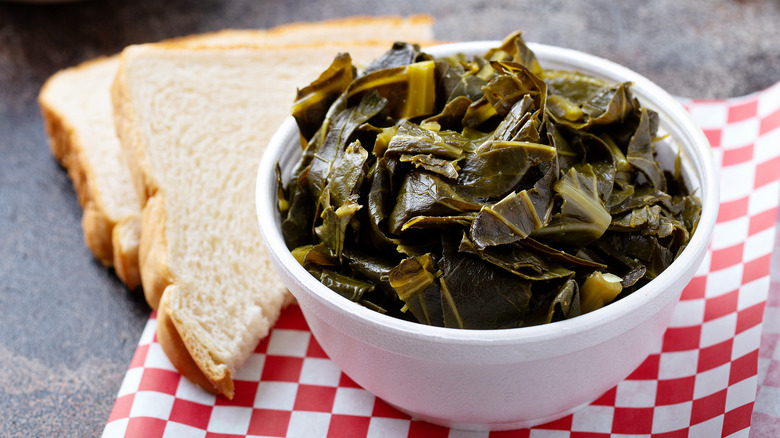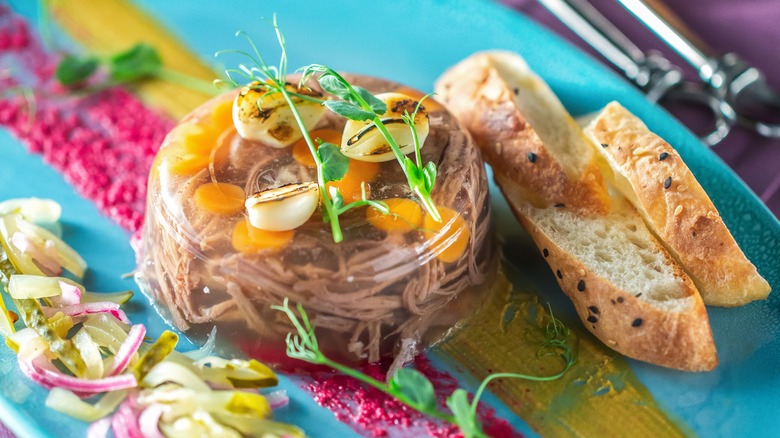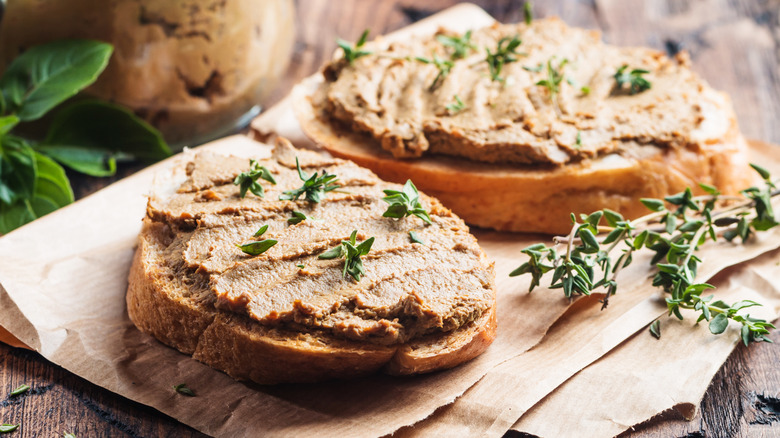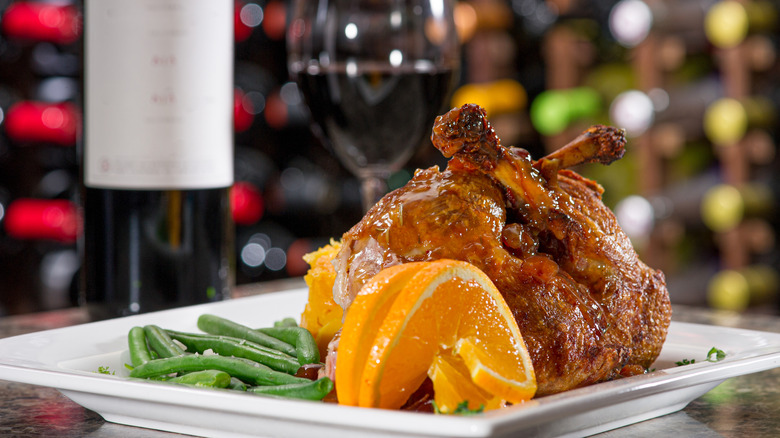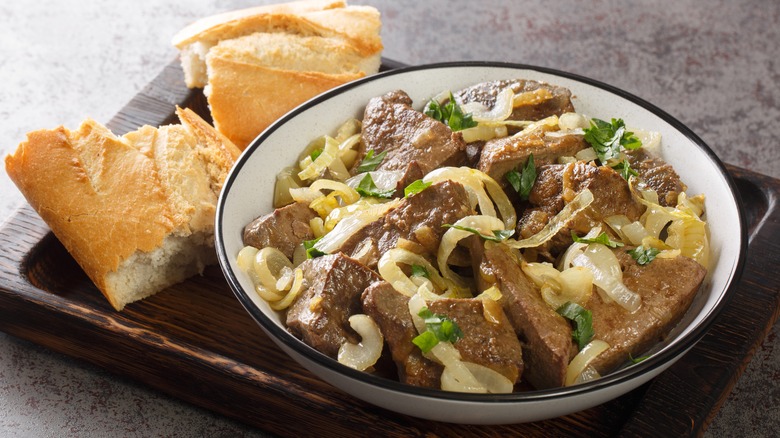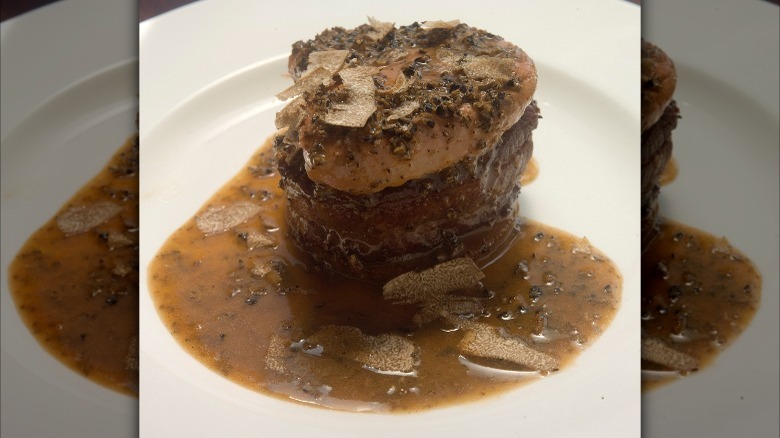The Best And Worst Old-School Dishes To Order At A Restaurant
We've noticed several unexpected old-school dishes showing up on restaurant menus lately. Trendy restaurants are discovering old favorites like grits, baked Alaska, and pimento cheese and serving them to their customers. As we poured through reviews for these retro dishes, the ones getting good and bad reviews weren't necessarily what we expected. Somehow, liver dishes and aspics are among the most liked, while time-honored dishes like meatloaf and deviled eggs aren't doing as well. Of course, sometimes it's about whether or not the restaurant is able to make food as good as your mama's, and the answer is often no.
Of the 22 retro dishes making a comeback on restaurant menus, five dishes aren't really passing muster. However, the other 17 are making waves. If you're lucky enough to see some of the standouts like beef Wellington, lobster Thermidor, or Tournedos Rossini the next time you dine out, we think you'll be pleasantly surprised if you give them a try.
Worst: Meatloaf
Something you may not have known about meatloaf is that it likely got its start in medieval Europe in the 500s C.E. as a way to use up leftover veggies and other ingredients. However, some food historians say meatloaf wasn't popular in the U.S. until the 1870s. With beef, onions, eggs, milk, and bread, this iteration it looked a lot closer to the meatloaf we recognize today.
Unfortunately, not all meatloaves are created equally, and when you're dining out, you have to contend with the possibility of mystery ingredients. When it's good, it's amazing, but not every place gets it right. Even in restaurants where diners usually rave about the meatloaf, it's possible to end up thinking it tastes odd if it's not like the meatloaf your mom makes.
Best: Pimento cheese
If you grew up in the southern part of the U.S., you were just as likely to have a pimento cheese sandwich in your school lunch box as a PB&J. The spread debuted in a 1908 Good Housekeeping recipe, but home cooks eventually replaced the pimento spread recipe's cream cheese and mustard with cheddar cheese chunks and mayonnaise After World War II.
Recently, pimento cheese has made its way to restaurant menus. Feltner Brothers in Fayetteville, Arkansas, has a wildly popular Hometown Burger on its menu served with pimento cheese instead of a slice of cheese. Meanwhile, New York City's Root and Bone is serving up its cheese grits with pimento cheese mixed in, and customers are loving it.
Worst: Oscar-style steak
Oscar-style steak comes to us by way of 19th-century Swedish king Oscar Frederik. The original recipe called for a stack of veal, crab meat, melted butter, and white asparagus. However, the dish has evolved now to include a nice piece of beef like filet mignon covered in a classic French sauce like bérnaise or hollandaise. The next layer is either lobster or crab meat with a couple of pieces of white or green asparagus resting on top.
The problem with ordering Oscar-style steak is that not every restaurant gets it right. If your steak is tough, it ruins the experience. Then, there's the problem of restaurants serving your steak hot while everything on top is cold. Plus, egg-based sauces like hollandaise and bérnaise are a breeding ground for bacteria that can cause food poisoning.
Best: Grits
Once upon a time, you only really found grits in the southern portion of the U.S. and almost exclusively for breakfast. But now, you'll find them on trendy menus across the U.S., and they're not just for the morning anymore. Chefs everywhere are experimenting with different ingredients to add to bring them to life. And the most popular pairing is usually shrimp and grits.
At Snooze, an A.M. Eatery, with locations around the country, the shrimp and grits contain tomatoes and mushrooms, with hot sauce for added heat. And at Red's Flavor Table in Inglewood, California, you might even find grits paired with salmon, jambalaya, or even short ribs.
Best: Lobster Thermidor
If your Sims game is the only place you've ever seen lobster Thermidor, you'll be happy to know you can now give this old-school dish a try in more restaurants than you once could. The original lobster Thermidor was served in 1894 in a Parisian restaurant called Chez Marie to mark the debut of a play called "Thermidor." While the play only lasted through three performances, the dish has endured.
The dish contains a steamed lobster covered with creamy sauce and melted cheese. Some recipes like Julia Child's call for vegetables, delicate herbs, and cognac. When diners try lobster Thermidor, they have nothing but praise for it. How can you go wrong with fresh seafood smothered in a creamy sauce and cheese?
Best: Pavlova
New Zealanders and Australians fight over who created the pavlova dessert to honor Russian ballerina Anna Pavlova, who danced in both their countries in the 1920s. Wherever it originated, it's delightful. Pavlovas are meringue-based cakes that are crisp on the outside and soft and marshmallow-like inside. They're layered with fresh or preserved fruit fillings, along with whipped cream and sometimes nuts.
You normally can't go wrong with ordering this retro menu item now that they've become more popular on menus. Since most come with fresh fruit, it's one of the most refreshing desserts you can find. You can find them in various flavors, including rum-soaked cherries and mascarpone, fluffernutter, passion fruit, chocolate, coconut panna cotta, and lemon cream.
Best: Anything with Bordelaise sauce
While French sauces containing eggs can be sketchy choices at a restaurant, choosing a dish with Bordelaise will make your mouth happy. This old-school sauce has become more popular recently in restaurants. Bordelaise originated in Bordeaux wine country in France, so its liquids are dry wine and broth. Basic recipes start out with shallots and butter, along with herbs like thyme, parsley, or bay leaves. The broth can range from beef broth to vegetable broth, and you might even find some mushrooms added in.
You'll most often find Bordelaise sauce topping your steak, although you could find it on other dishes like pork schnitzel or seafood as well. Even people who aren't big sauce fans tend to enjoy the depth of flavor that this one adds. If you see it on the menu, you're going to be glad you tried it.
Worst: Steak tartare
Steak tartare has been on French menus since the late 1800s, with diners becoming extremely fond of ordering the dish in the 1950s before it faded from menus. However, steak tartare is now among retro foods making a comeback. It tends to be wildly popular with anyone willing to brave eating a dish made with seasoned raw beef and raw eggs.
However, the real issue is whether or not steak tartare is safe to eat. According to the USDA, the raw meat and raw eggs in steak tartare have been linked to dangerous food poisoning outbreaks. Heating your meat and eggs beyond temperatures that keep them raw is the only way to kill bacteria that can lead to illness. So eating steak tartare is always a health risk.
Best: Gougères
As you can probably guess from the name, gougères are of French origin. These cheesy, light-as-air puff pastries are a delight. Nobody is quite sure of the origin, but they date back at least to the 1500s. Some say they were inspired by an Italian puff pastry recipe that Catherine de Medici's cooks brought to France when she became queen. However, the first mention historians can find of gougères by name comes from a 1571 wedding menu.
It's no surprise that you can find gougères in New Orleans since the cuisine is French-inspired. However, they're even available as appetizers in non-French restaurants in the midwest, like Novel Restaurant in Kansas City, Missouri. Customers find them delightful.
Worst: Deviled eggs
Cooks most likely began filling eggs with their own innards in Spain in the 1200s. While deviled eggs were once only a dish you usually saw at home or at potlucks, but they've evolved into a trendy restaurant appetizer. While very few people sit down and gobble up a large quantity of plain boiled eggs, once you've added a condiment like mayo and other flavoring components like bacon, people suddenly can't stop popping them in their mouths.
While you don't have to get your deviled eggs from grandma's kitchen anymore, getting them from a restaurant can be hit or miss. Some restaurants like Jar in Los Angeles are making interesting ones like crab deviled eggs that people love, but some flavors leave diners unhappy. And when restaurants make them too far in advance, they suffer in both texture and flavor.
Best: Oysters Rockefeller
This rich-tasting dish, named after billionaire John D. Rockefeller, owes its existence to substituting oysters for snails in escargot Bourguignon during an 1899 escargot shortage. Oysters Rockefeller originated in a New Orleans restaurant called Antoine's and features oysters topped with bread crumbs, shallots, garlic, spinach, Parmesan or Romano cheese, often Pernod, and sometimes cream, all blended together. The ingredients are baked in an oyster shell until golden brown.
Those who aren't a fan of the mucus-like texture of raw oysters often find Oysters Rockefeller to be far more palatable. It's really a great way to eat oysters in a landlocked city since they aren't served raw and you don't have to worry about the possibility of the oysters not being extremely fresh. When they come piping hot fresh out of the oven, customers rave about them.
Best: Baked Alaska
When your ice cream cake comes to your table covered in a fiery meringue, you can't help but be impressed. Chef Charles Ranhofer dreamed up the baked Alaska at Delmonico's Restaurant in New York City, New York, so it doesn't come from Alaska. Instead, this delightful dessert celebrated the 1867 acquisition of Alaska as a state.
The only people complaining about baked Alaska are people who find it suddenly missing from the menu. You just can't go wrong with a flaming layered ice cream cake. It's not only a production piece that turns dessert into an experience, but it also tastes amazing. So if you ever see this old-school dish on the menu, be sure to save room for dessert.
Best: Popovers
The first references historians have found to popovers are in an 1850 letter and an 1876 "Practical Cooking" cookbook recipe. When English immigrants came to the U.S., they ended up creating popovers as an alternative to Yorkshire pudding. Both are savory flour-based confections made with eggs, butter, and milk and cooked in beef fat. However, the main difference is that popovers are baked in deeper pans, making them taller than Yorkshire pudding.
While popovers haven't been popular in the U.S. for quite some time, they've started popping up in various restaurants across the U.S. lately. Restaurants are filling them with everything from cheese to liver mousse or even making them sweet by stuffing them with cherry filling. Overall, diners are embracing them and loving them.
Worst: Wedge salad
The humble wedge salad first shows up in the 1916 "Salads, Sandwiches and Chafing Dish Recipes" cookbook. Within a few years, restaurants across the U.S. were placing an intact wedge of iceberg lettuce on a plate with a few extra ingredients and calling it a salad. The dish morphed over time to include crumbles of bacon and blue cheese and a topping of creamy dressing.
In the past few years, the lazy salad maker's dream salad has made a comeback on restaurant menus. Unfortunately, it's hit or miss. Customers complain about getting lettuce that's not very fresh or all white rather than green. Some miss having more toppings like tomato or red onions. It is a simple salad, but not every restaurant is getting it right, especially when their focus is more on the quality of their meat rather than their produce.
Best: Beef Wellington
Beef Wellington is another celebratory dish which marks the English Duke of Wellington's defeat of Napoleon in the Battle of Waterloo in 1815. While there's a reference to it in a 1903 Los Angeles Times article, it didn't become wildly popular in the U.S. until chef Julia Child made it on her cooking show in 1965. Still, many of us have never had this delectable pastry-encrusted beef dish. Luckily, this old-school dish is showing up on restaurant menus lately.
While most restaurants are making their customers universally happy with traditional beef Wellingtons, some, like Temple Court in New York City, make it with venison instead. It's important to note that your beef Wellington will come pink in the middle to avoid overcooking the pastry, so lovers of well-done meat should steer clear.
Best: Southern greens
Until recently, southerners who visited other regions or moved out of the South weren't able to easily find their beloved collard and turnip greens. These core vegetables in southern and soul food cooking can be bitter if not cooked correctly. But when you find someone who knows how to cook them, they're flavorful and delicious.
Rather than only looking for greens in the South or in southern food restaurants, you can now even find turnips and collards in far-flung places all over. And they're not only in southern restaurants anymore. It's important to note that turnips and collards often contain pork for flavoring. So, if you're a vegetarian or don't eat pork, it's a good idea to ask about the meat content before ordering.
Best: Aspics
While aspics are a common part of some world cuisines, in the U.S., they tend to inspire mental images of random savory foods floating in clear Jello that 1950s housewives likely made to get their husbands to splurge on a restaurant meal for the evening. However, aspics have been around since at least the 1300s. When people try to cook through all of Julia Child's cookbooks, they often don't make it through more than one bite of the aspics.
Inspired by the charcuterie craze, eateries like San Francisco's Maison Nico are experimenting with placing savory foods in gelatin-induced suspended animation. Adventurous eaters looking for a food experience can now order aspics in select restaurants. These aren't your grandma's aspics. They may contain ham, caviar, crab, eggs, and even cold chicken. Surprisingly to us, good chefs have people giving rave reviews to this old-school dish.
Best: Chicken liver pâté
The French have been making liver pâtés for centuries, with specific ones like pâté de foie gras first appearing in the 1700s. While chicken liver was often among the pieces of a chicken many of us avoided as a child, turning it into a flavorful pâté has the capacity to delight our palates. Adding chicken stock, butter, garlic, onion, and brandy to a strong and earthy liver transforms it into something worthy of a fine restaurant.
Throughout cities like New York, you'll find chicken liver pâtés on scores of menus, with many restaurants serving it with tasty bread for spreading. Diners absolutely adore them, often finding that they like them even better than foie gras spreads.
Best: Duck l'orange
Like with gougères, it's rumored that Catherine de Medici's cooks brought duck l'orange to France from Italy when she became queen in the 1500s. However, the first mention of the dish was actually in a Tuscan recipe collection from the 1300s called "Libro Della Cucina." Many people in the U.S. who know this orange- and brandy-glazed roast duck know it either from Julia Child's cookbooks or from eating it in a restaurant in the 1960s.
Now, moist and flavorful duck l'orange dishes are delighting people again as we find them on more restaurant menus. Everything from the crisp skin to the delectable citrusy glaze is wowing customers and keeping them coming back for more.
Best: Casseroles
While we're not exactly sure when casseroles first appeared in kitchens, but they go back at least to the 1700s. However, it wasn't until the Great Depression that they became a staple of U.S. cuisine when home cooks were trying to stretch ingredients as far as possible.
Old-school casseroles are showing back up on restaurant menus, and they're doing better than you'd expect for a retro dish that is often reheated rather than made fresh. Cracker Barrel has had a perpetual hit with its hashbrown casserole. However, restaurants are now churning out all sorts of comforting casseroles, including old favorites like green bean casserole, and more inventive dishes like lamb chop casserole, spaghetti squash casserole, and seafood casserole.
Best: Liver and onions
Liver and onions may not be at the top of everyone's list of old-school foods to order at a restaurant. However, many people grew up eating this dish because liver was cheap and it packs lots of nutrients. Among other vitamins and minerals, liver provides 3,460% of your daily vitamin B12 needs, 1,620% of your daily copper needs, up to 1,100% of your daily vitamin A needs, and up to 260% of your daily vitamin B2 needs, reports Healthline.
If the idea of liver and onions activates your nostalgia, you're probably more likely than others to order the dish when you find it on a restaurant menu. And the strong flavors of organ meat and onions aren't just showing up in small rural diners as you'd expect, but also in fancier big city restaurants from New York to L.A.
Best: Tournedos Rossini
It turns out that people like liver more than you'd think because it is also showing up on menus as a component of Tournedos Rossini. This old-school dish starts out with a piece of beef steak atop of a slice of toasted bread. Then the cook adds a layer of foie gras, truffle slices, and plenty of Madeira sauce to cascade over the layers. A chef first made this exquisite yet comforting dish for Italian composer Gioachino Antonio Rossini in the 1800s.
Whether diners order rib eye, filet mignon, or some other steak cut for their Tournedos Rossini, they're always ecstatic about their culinary experience. Even in the heart of plain steak country, like St. Martins in Dallas, Texas, diners are loving the Tournedos Rossini's comeback.
